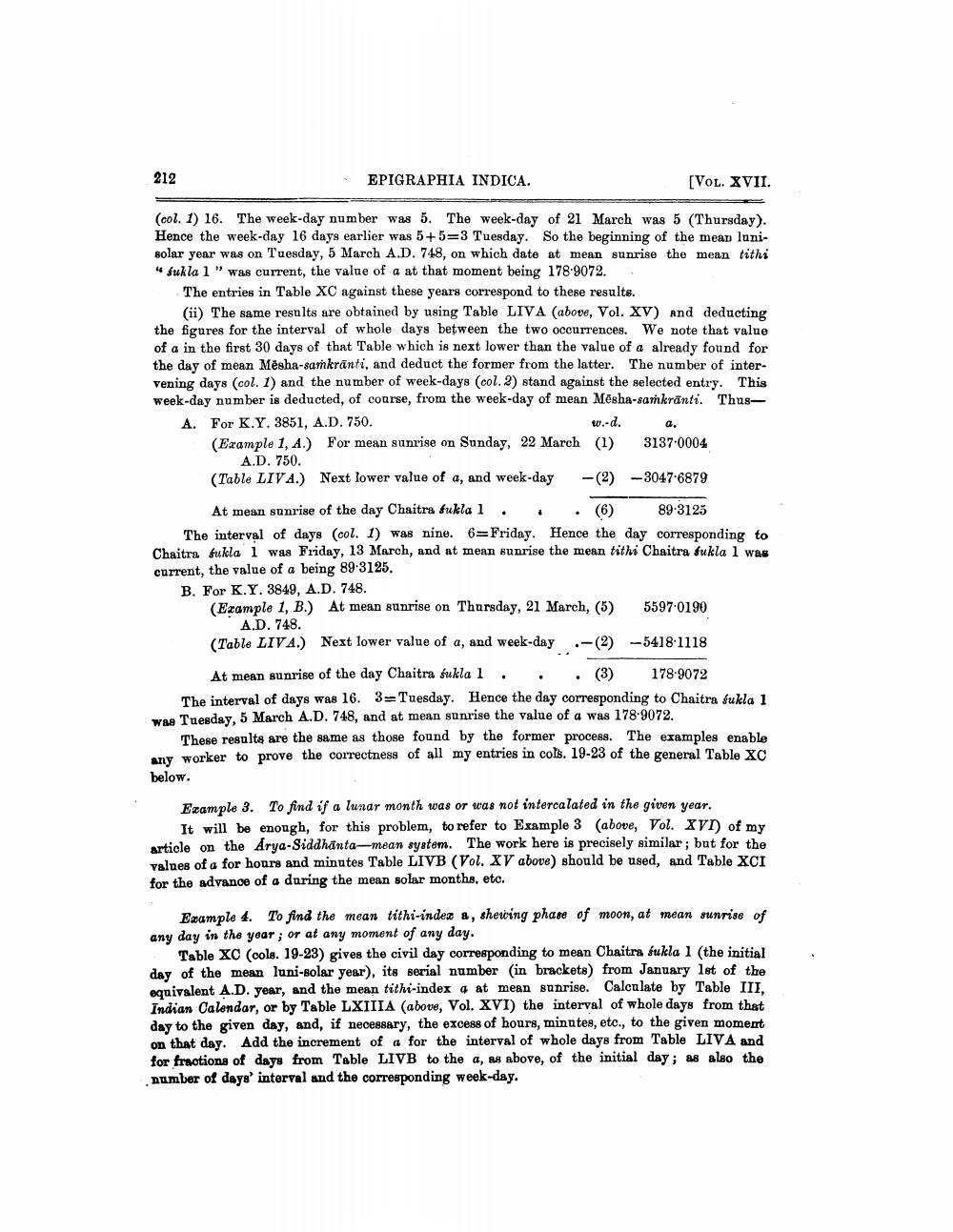________________
212
EPIGRAPHIA INDICA.
[Vol. XVII.
(col. 1) 16. The week-day number was 5. The week-day of 21 March was 5 (Thursday). Hence the week-day 16 days earlier was 5+5=3 Tuesday. So the beginning of the mean luni. solar year was on Tuesday, 5 March A.D. 748, on which date at mean sunrise the mean tithi "Sukla 1" was current, the value of a at that moment being 178-9072.
The entries in Table XC against these years correspond to these results.
(ii) The same results are obtained by using Table LIVA (above, Vol. XV) and deducting the figures for the interval of whole days between the two occurrences. We note that value of a in the first 30 days of that Table which is next lower than the value of a already found for the day of mean Mesha-samkrānti, and deduct the former from the latter. The number of intervening days (col. 1) and the number of week-days (col. 2) stand against the selected entry. This week-day number is deducted, of course, from the week-day of mean Mosha-sankranti. ThusA. For K.Y. 3851, A.D. 750.
w.-d. a. (Example 1, A.) For mean sunrise on Sunday, 22 March (1) 3137.0004
A.D. 750. (Table LIVA.) Next lower value of a, and week-day -(2) -3047.6879
At mean sunrise of the day Chaitra fukla 1 . . . (6) 89-3125 The interval of days (col. 1) was nine. 6=Friday. Hence the day corresponding to Chaitra sukla i was Friday, 13 March, and at mean sunrise the mean tithi Chaitra fukla 1 was current, the value of a being 89-3125. B. For K.Y. 3849, A.D. 748. (Example 1, B.) At mean sunrise on Thursday, 21 March (5) 5597-0190
A.D. 748. (Table LIVA.) Next lower value of a, and week-day .-(2) --54181118
At mean sunrise of the day Chaitra sukla 1 . . . (3) 178-9072 The interval of days was 16.3=Tuesday. Hence the day corresponding to Chaitra sukla 1 was Tuesday, 5 March A.D. 748, and at mean sunrise the value of a was 178.9072.
These results are the same as those found by the former process. The examples enable any worker to prove the correctness of all my entries in cols. 19-23 of the general Table XC below.
Example 3. To find if a lunar month was or was not intercalated in the given year.
It will be enough, for this problem, to refer to Example 3 (above, Vol. XVI) of my article on the Arya-Siddhānta-mean system. The work here is precisely similar ; but for the values of a for hours and minutes Table LIVB (Vol. XV above) should be used, and Table XCI for the advance of a during the mean solar months, etc.
Example 4. To find the mean tithi-index a, shewing phase of moon, at mean sunrise of any day in the year; or at any moment of any day.
Table XC (colo. 19-23) gives the civil day corresponding to mean Chaitra bukla 1 (the initial day of the mean luni-solar year), its serial number in brackets) from January 1st of the equivalent A.D. year, and the mean tithi-index at mean sunrise. Calculate by Table III, Indian Calendar, or by Table LXIIIA (above, Vol. XVI) the interval of whole days from that day to the given day, and, if necessary, the excess of hours, minutes, etc., to the given moment on that day. Add the increment of a for the interval of whole days from Table LIVA and for fractions of days from Table LIVB to the a, as above, of the initial day; as also the number of days' interval and the corresponding week-day.




